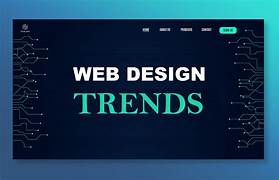“Top 10 Web Design Trends for 2025”
The world of web design is constantly evolving, and 2025 is set to bring some of the most innovative trends yet. As technology continues to advance, designers and developers are finding new ways to enhance user experience and engagement. In this article, we’ll explore the top 10 web design trends for 2025 that are shaping the future of the digital landscape.
1. Immersive 3D Visuals
3D design has been gaining traction for years, and 2025 will see it fully integrated into web design. Immersive 3D visuals create a dynamic and engaging user experience, making websites feel more interactive. From product showcases to interactive storytelling, 3D elements captivate users and keep them engaged longer.
2. AI-Powered Personalization
Artificial intelligence is transforming how users interact with websites. In 2025, AI-driven personalization will become more advanced, offering tailored content, product recommendations, and user experiences based on individual preferences. This trend ensures that users feel valued and understood, boosting engagement and conversion rates.
3. Voice-Activated Interfaces
Voice search is becoming increasingly popular, and web design is adapting to accommodate this shift. Websites in 2025 will feature voice-activated interfaces, allowing users to navigate and interact using voice commands. This trend is particularly beneficial for accessibility, making websites more inclusive.
4. Minimalist Design with a Twist
Minimalism continues to dominate, but with a modern twist. Expect bold typography, vibrant gradients, and unique layouts that add personality to minimalist designs. This approach creates visually appealing websites that are easy to navigate and focus on delivering key messages effectively.
5. Dark Mode Optimization
Dark mode has become a staple feature, and 2025 will see it optimized further. Designers are focusing on creating stunning dark mode designs that reduce eye strain and enhance the visual appeal of websites. This trend is particularly popular for mobile devices and apps.
6. Augmented Reality (AR) Integration
Augmented reality is making its way into web design, offering users interactive and immersive experiences. From virtual try-ons for e-commerce to interactive maps for travel websites, AR enhances user engagement and adds a new layer of functionality to websites.
7. Advanced Micro-Interactions
Micro-interactions are subtle animations or effects that enhance user interaction. In 2025, they’ll become more sophisticated, guiding users through websites seamlessly. From hover effects to scrolling animations, micro-interactions improve usability and make websites feel more intuitive.
8. Sustainable Web Design
As sustainability becomes a global priority, web designers are adopting eco-friendly practices. This includes optimizing website performance to reduce energy consumption, using green hosting providers, and designing lightweight websites that load quickly. Sustainable design is not only good for the planet but also improves user experience.
9. Inclusive Design
Accessibility and inclusivity are at the forefront of web design. In 2025, more websites will prioritize inclusive design, ensuring they are usable by people of all abilities. This includes features like screen reader compatibility, keyboard navigation, and color schemes suitable for users with visual impairments.
10. Enhanced Cybersecurity Features
With the rise of cyber threats, cybersecurity is a critical aspect of web design. Websites in 2025 will feature advanced security measures, such as multi-factor authentication, secure payment gateways, and encrypted data storage. A focus on security builds trust and ensures a safe user experience.
Why These Trends Matter
The web design trends for 2025 are not just about aesthetics; they’re about creating functional, user-friendly, and innovative websites that meet the needs of modern users. By adopting these trends, businesses can stay competitive, improve user satisfaction, and achieve their digital goals.
How to Implement These Trends
To incorporate these trends into your website:
- Stay Informed: Keep up with the latest tools and technologies in web design.
- Prioritize User Experience: Focus on creating designs that are intuitive and accessible.
- Collaborate with Experts: Work with experienced designers and developers to bring your vision to life.
- Test and Optimize: Continuously test your website’s performance and make improvements based on user feedback.
